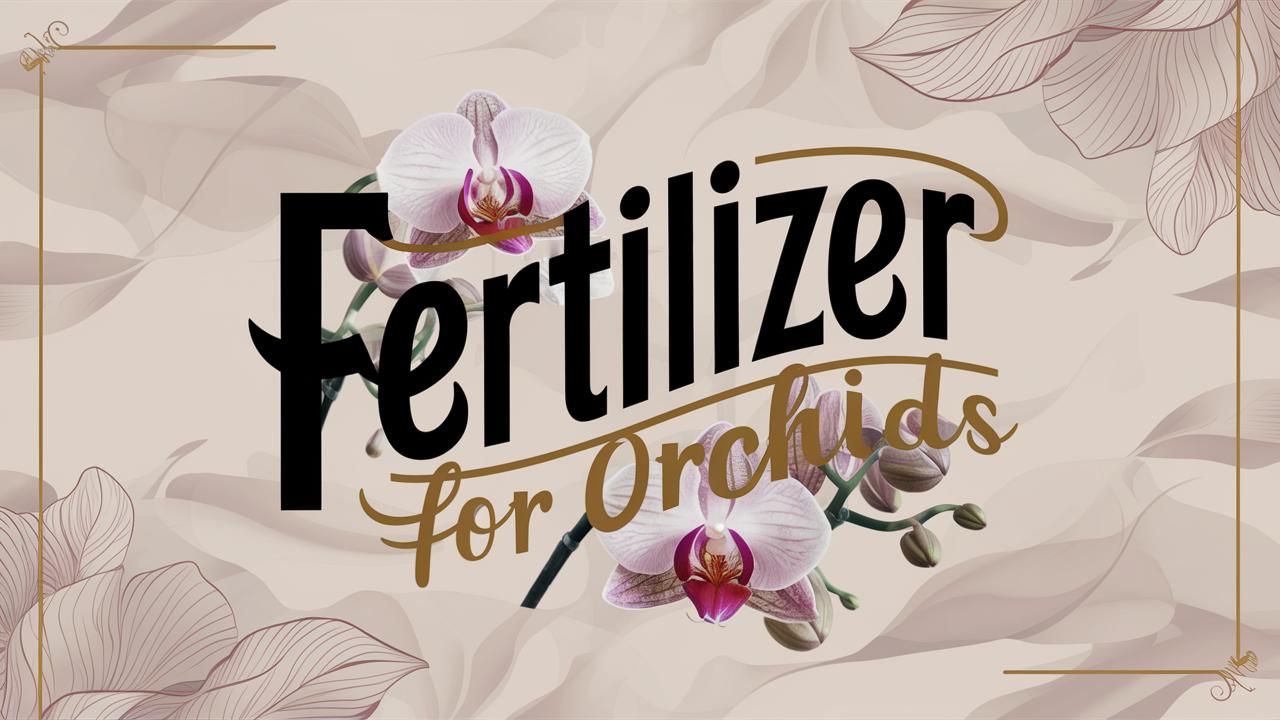In this guide, we will help you choose the best fertilizer for your orchids, ensuring they thrive and bloom beautifully.
Fertilizer For Orchids
| Image | Name | Rating | Shop |
|---|---|---|---|
 | Miracle-Gro Orchid Plant Food |  | |
 | Grow More Orchid Fertilizer |  | |
 | Gold Standard Orchid Fertilizer |  |
Miracle-Gro Orchid Plant Food
The Miracle-Gro Ready to Use Orchid Plant Food Mist is a great option for indoor enthusiasts who want to provide their orchids with the right nutrients at the right time.
For indoor orchid owners, this plant food mist is a convenient and hassle-free way to feed your plants. It’s safe to use on various types of indoor orchids, including Phalaenopsis, Cattleya, and Dendrobium species. With its easy-to-use spray formula, you can simply apply the mist once per week, avoiding the flowers to prevent damage. The bundle comes with three 8 oz bottles, making it a cost-effective option for long-term use. Overall, the Miracle-Gro Ready to Use Orchid Plant Food Mist is a great addition to any indoor orchid care routine.
Grow More Orchid Fertilizer
For growers looking to encourage vibrant blooms and healthy growth in their orchids year-round, we recommend using the Grow More All Purpose Orchid Fertilizer 20-20-20. This balanced fertilizer formula is designed to increase vitality and robustness in all types of orchids, regardless of season or growing medium.
This versatile solution can be used on a variety of orchids, including cattleyas, vandas, dendrobiums, and more, with exposed roots compatible for slab-mounted epiphytic varieties. The 20-20-20 water soluble formula is easy to apply and enhances nutrient absorption to ensure your orchids are getting the most out of every drop of fertilizer. Additionally, this product is made in the USA by a company that specializes in plant care products.
Gold Standard Orchid Fertilizer
One good fertilizer option for caring for your orchids is the rePotme Orchid Food – Feed ME! MSU Orchid Fertilizer. This product has a reputation for being reliable and trustworthy among professionals and hobbyists alike.
This urea-free, gentle formulation is suitable for any type of orchid or houseplant, making it a versatile choice. The fertilizer is also designed to work well with RO (reverse osmosis), rain, or tap water that may be low in alkalinity. Simply follow the instructions on the label to ensure proper application.
Orchid Bloom Fertilizer.
This product, Orchid Plant Food (5 oz, 50+ Applications), is a solid choice for any homeowner looking to provide the nutrients their orchids need. The blend of macro and micronutrients, combined with added calcium, sulfur, and magnesium, helps promote healthy growth, vibrant blooms, and overall plant vitality.
If you’re in the market for a slow release fertilizer that can keep your orchid thriving for months at a time, this product is definitely worth considering. With its granular formula and easy-to-use design, simply poking holes or sprinkling around the potting mix allows for consistent feeding without any hassle. Plus, one 5-ounce pouch lasts an astonishing 50+ applications even with orchids in larger pots!
Orchid Fertilizer Spikes
Miracle-Gro Orchid Plant Food Spikes seem like a decent choice for those looking to give their orchids some extra nutrients. The product is designed to promote healthy growth and blooming, which can make for a nice-looking indoor plant.
The spikes are fairly convenient as they’re easy to use – just stick them into the potting mix, and you’re good to go. They also last up to 2 months, depending on how often your orchid needs watering (which is generally quite infrequently). It’s worth noting that it’s recommended to only fertilize during periods of active growth.
Orchid Bloom Booster
For orchids that require an extra boost to promote healthy growth and vibrant blooms, we recommend using Company 8305 Better Gro Orchid Plus Bloom Booster Fertilizer. This specialized fertilizer is specifically designed for the unique needs of orchids, providing essential nutrients to support strong root development and encourage stunning flower blooms.
This 16-ounce bottle is a convenient size for regular applications and is easy to use as part of your orchid care routine. Simply dilute the fertilizer according to the instructions provided and water your orchids as you normally would. With its balanced formula, this product helps ensure that your orchids receive all the necessary nutrients to thrive and flourish.
How To Choose The Best Fertilizer For Orchids
Orchids are among the most exquisite and diverse flowering plants, captivating plant enthusiasts with their stunning blooms and enchanting fragrance. However, they can also be notoriously finicky when it comes to care, particularly in their nutritional needs. One of the most critical aspects of orchid care is selecting the right fertilizer.
Understanding Orchid Nutritional Needs
Before diving into specific fertilizers, it’s essential to understand what orchids need in terms of nutrition. Orchids, like all plants, require macronutrients and micronutrients to grow healthily.
Macronutrients
The three primary macronutrients necessary for orchid growth are:
Nitrogen (N): Vital for vegetative growth, nitrogen promotes robust root development, lush foliage, and helps in the overall assimilation of other nutrients.
Phosphorus (P): This nutrient is essential for flowering and root establishment. It aids in energy transfer within the plant and is crucial during the flowering stage.
Potassium (K): Potassium contributes to overall plant health by regulating water uptake, enhancing disease resistance, and promoting strong stems and blooms.
Micronutrients
Besides the macronutrients, orchids also require various micronutrients, such as:
Iron: Important for chlorophyll production and preventing yellowing of leaves.
Magnesium: Plays a vital role in photosynthesis.
Calcium: Crucial for cell structure and promotes root growth.
Each type of orchid may have different requirements, so knowing the specific needs of your orchid species is crucial when selecting fertilizer.
Types of Fertilizers Available for Orchids
When it comes to fertilizers, you will find a plethora of options available on the market. Each type serves a different purpose and suitability for various growth stages. Let’s explore the types of fertilizers best suited for orchids.
Water-Soluble Fertilizers
Water-soluble fertilizers are a popular choice among orchid enthusiasts because they are easy to use and allow for precise control over nutrient delivery. They come in various formulations, often labeled with an N-P-K ratio (Nitrogen-Phosphorus-Potassium). For orchids, a balanced fertilizer with an N-P-K ratio of 30-10-10, 20-20-20, or 10-30-20 may be recommended depending on the growth stage.
These fertilizers are typically diluted in water and applied during the growing season. Regular feeding every two weeks or month, depending on the type of orchid, can promote vigorous growth and blooming.
Slow-Release Fertilizers
Slow-release fertilizers contain nutrients that are gradually released over time, providing a steady supply of nutrition for orchids without the risk of over-fertilization. These fertilizers are ideal for busy orchid growers who might forget to fertilize regularly. They generally come in granular form and can be mixed into the potting mix.
When using slow-release fertilizers, it’s essential to follow the package instructions carefully. Typically, these fertilizers provide nutrition for several months, so monitoring your orchids for signs of nutrient deficiency is crucial during this period.
Organic Fertilizers
For those looking to embrace organic gardening practices, organic fertilizers offer an excellent alternative. These fertilizers often come in the form of compost, worm castings, or kelp meal and are derived from natural sources. Organic fertilizers improve soil health by introducing beneficial microorganisms and organic matter.
While organic fertilizers may release nutrients more slowly than synthetic options, many gardeners find that they promote better overall plant health and resilience. However, it’s essential to apply organic fertilizers correctly, as over-application can lead to nutrient imbalances.
Special Orchid Fertilizers
Specialized orchid fertilizers are tailored specifically for the unique needs of orchids. They often contain controlled-release formulations designed to provide the essential macronutrients and micronutrients in a suitable balance for orchids.
These fertilizers may include additional components to address common deficiencies in orchids, helping to boost growth and flower quality. If you’re serious about nurturing your orchids, investing in a high-quality orchid-specific fertilizer can yield fantastic results.
Timing Is Everything: When to Fertilize Orchids
The effectiveness of fertilization largely depends on timing. Orchids follow a seasonal growth pattern, and understanding their needs during different phases is vital for optimal nourishment.
Spring and Summer: Growing Season
Spring and summer mark the active growth period for most orchids. During these months, it’s crucial to provide consistent fertilization to support leaf and root development. Generally, watering with diluted fertilizer every two to four weeks during the growing season can be beneficial.
Fall and Winter: Dormant Season
As fall approaches, many orchids enter a dormant phase where growth slows, and in some cases, flowering ceases. During this period, it’s advisable to reduce the frequency of fertilization. One approach is to switch to a diluted fertilizer application once a month or every six weeks. This method ensures that the orchids receive nutrients without overwhelming them during their sleep period.
Factors to Consider When Choosing Fertilizer
Not all fertilizers are created equal, and choosing the right one for your orchids may come down to several factors. Here are some crucial considerations to keep in mind:
1. Type of Orchid
Different species of orchids have specific nutrient requirements. For instance, Phalaenopsis orchids prefer fertilizers higher in nitrogen during growth, while Cattleya orchids benefit from higher phosphorus levels during blooming. Always research the specific needs of your orchid species to tailor your fertilizer choice.
2. Growth Stage
Consider the growth stage of your orchid. During the active growing phase, nitrogen-rich fertilizers are crucial, while during the blooming stage, phosphorus and potassium should take precedence to promote flowering.
3. Potting Medium
The potting medium you use can influence how your plant absorbs nutrients. For example, orchids grown in bark may require more frequent fertilization since bark mixes decompose and release nutrients more rapidly than a potting mix. Conversely, orchids in heavier soil may retain nutrients longer.
4. Water Quality
Another significant factor to consider is the quality of water used when mixing fertilizers. Tap water can contain chlorine or other chemicals that may affect nutrient uptake. If possible, use distilled or rainwater for a healthier growing environment.
Tips for Successful Fertilization
To help you achieve the best results while fertilizing your orchids, here are a few practical tips:
1. Dilution is Key
Always dilute your fertilizer according to the manufacturer’s instructions. Over-fertilization can lead to salt buildup, damaging your orchid’s roots and ultimately harming the plant.
2. Test First
Before committing to a new fertilizer, consider testing it on a small section or a less critical plant. Observing how it affects the plant can help prevent potential disasters.
3. Observe and Adjust
Watch your orchids closely for signs of nutrient deficiencies or excesses. Yellowing leaves, stunted growth, or poor blooming may indicate the need for adjusting your fertilization routine or changing fertilizers entirely.
4. Flush Regularly
To help prevent nutrient buildup, flush your potting medium with clean water every few months. This practice helps eliminate excess salts from fertilizer residues, fostering better nutrient absorption.
5. Keep Records
Maintaining a journal can help track your orchids’ fertilization schedule, growth, and blooming patterns. This documentation can be extremely valuable for future care and making necessary adjustments to your approach.
Common Mistakes to Avoid
Fertilizing orchids can be rewarding but can also lead to unnecessary stress if mistakes are made. Here are some common missteps to avoid:
1. Over-Fertilizing
One of the most notorious mistakes is over-fertilizing. Remember: Orchids are often less demanding than other houseplants, so it’s better to err on the side of caution. A light feeding goes a long way!
2. Underestimating Root Health
Healthy roots are fundamental to your orchid’s overall health. If the roots are damaged or rotting, they cannot effectively use the nutrients provided in fertilizers. Focus on repotting and root care regularly.
3. Ignoring Environmental Factors
Conditions like light, humidity, and temperature can all impact an orchid’s fertilization needs. An orchid stressed by low light or inconsistent humidity may benefit from less fertilizer temporarily.
Final Thoughts
Choosing the best fertilizer for orchids is a vital aspect of successful orchid cultivation. While each orchid species may have its nuances, understanding general nutritional needs, timing of application, and observing the effects of fertilization are crucial steps to achieving robust growth and beautiful blooms.








